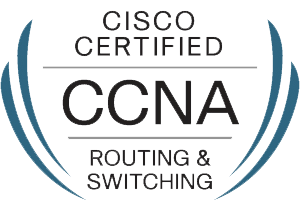
Here is your exam objectives tracker for ICND2. Remember – there are five parts. So if you are not seeing all five below – be sure to click on the READ MORE button!
| 1.0 | LAN Switching Technologies |
| 1.1 | Configure, verify, and troubleshoot VLANs |
| (normal/extended range) spanning multiple switches | |
| 1.1.a | Access ports (data and voice) |
| 1.1.b | Default VLAN |
| 1.2 | Configure, verify, and troubleshoot interswitch connectivity |
| 1.2.a | Add and remove VLANs on a trunk |
| 1.2.b | DTP and VTP (v1&v2) |
| 1.3 | Configure, verify, and troubleshoot STP protocols |
| 1.3.a | STP mode (PVST+ and RPVST+) |
| 1.3.b | STP root bridge selection |
| 1.4 | Configure, verify, and troubleshoot STP-related optional features |
| 1.4.a | PortFast |
| 1.4.b | BPDU guard |
| 1.5 | Configure, verify, and troubleshoot (Layer 2/Layer 3) EtherChannel |
| 1.5.a | Static |
| 1.5.b | PAGP |
| 1.5.c | LACP |
| 1.6 | Describe the benefits of switch stacking and chassis aggregation |
| 1.7 | Describe common access layer threat mitigation techniques |
| 1.7.a | 802.1x |
| 1.7.b | DHCP snooping |
| 1.7.c | Nondefault native VLAN |
| 2.1 | Configure, verify, and troubleshoot Inter-VLAN routing |
| 2.1.a | Router on a stick |
| 2.1.b | SVI |
| 2.2 | Compare and contrast distance vector and link-state routing protocols |
| 2.3 | Compare and contrast interior and exterior routing protocols |
| 2.4 | Configure, verify, and troubleshoot single area and multiarea OSPFv2 for IPv4 |
| (excluding authentication, filtering, manual summarization, redistribution, stub, virtual-link, and LSAs) | |
| 2.5 | Configure, verify, and troubleshoot single area and multiarea OSPFv3 for IPv6 |
| (excluding authentication, filtering, manual summarization, redistribution, stub, virtual-link, and LSAs) | |
| 2.6 | Configure, verify, and troubleshoot EIGRP for IPv4 |
| (excluding authentication, filtering, manual summarization, redistribution, stub) | |
| 2.7 | Configure, verify, and troubleshoot EIGRP for IPv6 |
| (excluding authentication, filtering, manual summarization, redistribution, stub) | |
| 3.1 | Configure and verify PPP and MLPPP on WAN interfaces using local authentication |
| 3.2 | Configure, verify, and troubleshoot PPPoE client-side interfaces using local authentication |
| 3.3 | Configure, verify, and troubleshoot GRE tunnel connectivity |
| 3.4 | Describe WAN topology options |
| 3.4.a | Point-to-point |
| 3.4.b | Hub and spoke |
| 3.4.c | Full mesh |
| 3.4.d | Single vs dual-homed |
| 3.5 | Describe WAN access connectivity options |
| 3.5.a | MPLS |
| 3.5.b | MetroEthernet |
| 3.5.c | Broadband PPPoE |
| 3.5.d | Internet VPN (DMVPN, site-to-site VPN, client VPN) |
| 3.6 | Configure and verify single-homed branch connectivity using eBGP IPv4 |
| (limited to peering and route advertisement using Network command only) | |
| 4.1 | Configure, verify, and troubleshoot basic HSRP |
| 4.1.a | Priority |
| 4.1.b | Preemption |
| 4.1.c | Version |
| 4.2 | Describe the effects of cloud resources on enterprise network architecture |
| 4.2.a | Traffic path to internal and external cloud services |
| 4.2.b | Virtual services |
| 4.2.c | Basic virtual network infrastructure |
| 4.3 | Describe basic QoS concepts |
| 4.3.a | Marking |
| 4.3.b | Device trust |
| 4.3.c | Prioritization |
| 4.3.c.i | Voice |
| 4.3.c.ii | Video |
| 4.3.c.iii | Data |
| 4.3.d | Shaping |
| 4.3.e | Policing |
| 4.3.f | Congestion management |
| 4.4 | Configure, verify, and troubleshoot IPv4 and IPv6 access list for traffic filtering |
| 4.4.a | Standard |
| 4.4.b | Extended |
| 4.4.c | Named |
| 4.5 | Verify ACLs using the APIC-EM Path Trace ACL analysis tool |
| 5.1 | Configure and verify device-monitoring protocols |
| 5.1.a | SNMPv2 |
| 5.1.b | SNMPv3 |
| 5.2 | Troubleshoot network connectivity issues using ICMP echo-based IP SLA |
| 5.3 | Use local SPAN to troubleshoot and resolve problems |
| 5.4 | Describe device management using AAA with TACACS+ and RADIUS |
| 5.5 | Describe network programmability in enterprise network architecture |
| 5.5.a | Function of a controller |
| 5.5.b | Separation of control plane and data plane |
| 5.5.c | Northbound and southbound APIs |
| 5.6 | Troubleshoot basic Layer 3 end-to-end connectivity issues |